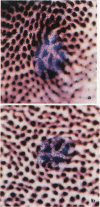Abstract
Carcinogen-treated rats develop foci of aberrant crypts in the colon (ACFs) that have been interpreted as preneoplastic lesions. To characterise ACFs further, we studied in the unsectioned colon of rats the number, multiplicity, some morphological characteristics and the type of mucin production in ACFs. In ACFs observed 115 days after the administration of 50 mg kg-1 1,2-dimethylhydrazine (DMH), crypt multiplicity [number of aberrant crypts (AC) per focus] was positively correlated (P < 0.0001) with the reduction of goblet cells, and with luminal and nuclear alterations in the cells surrounding the lumen of the ACs. We studied mucin production in the unsectioned colon, demonstrating that ACFs producing sulphomucins (like the normal distal rat colon) were progressively reduced when ACF multiplicity increased, whereas ACFs containing sialomucins (correlated with an increased risk of colon cancer) or both sulphomucins and sialomucins increased with crypt multiplicity. We also studied ACFs in the colon and the occurrence of intestinal tumours in rats treated with azoxymethane (AOM; 64 mg kg-1). A significant association was found (P = 0.04) between tumours and the presence of 'large' ACFs (AC/ACF > 14 crypts) and a borderline significant association (P = 0.057) between the presence of tumours and sialomucin-producing ACFs. We found no association between the number of ACFs, ACF multiplicity and the presence of tumours.
Full text
PDF
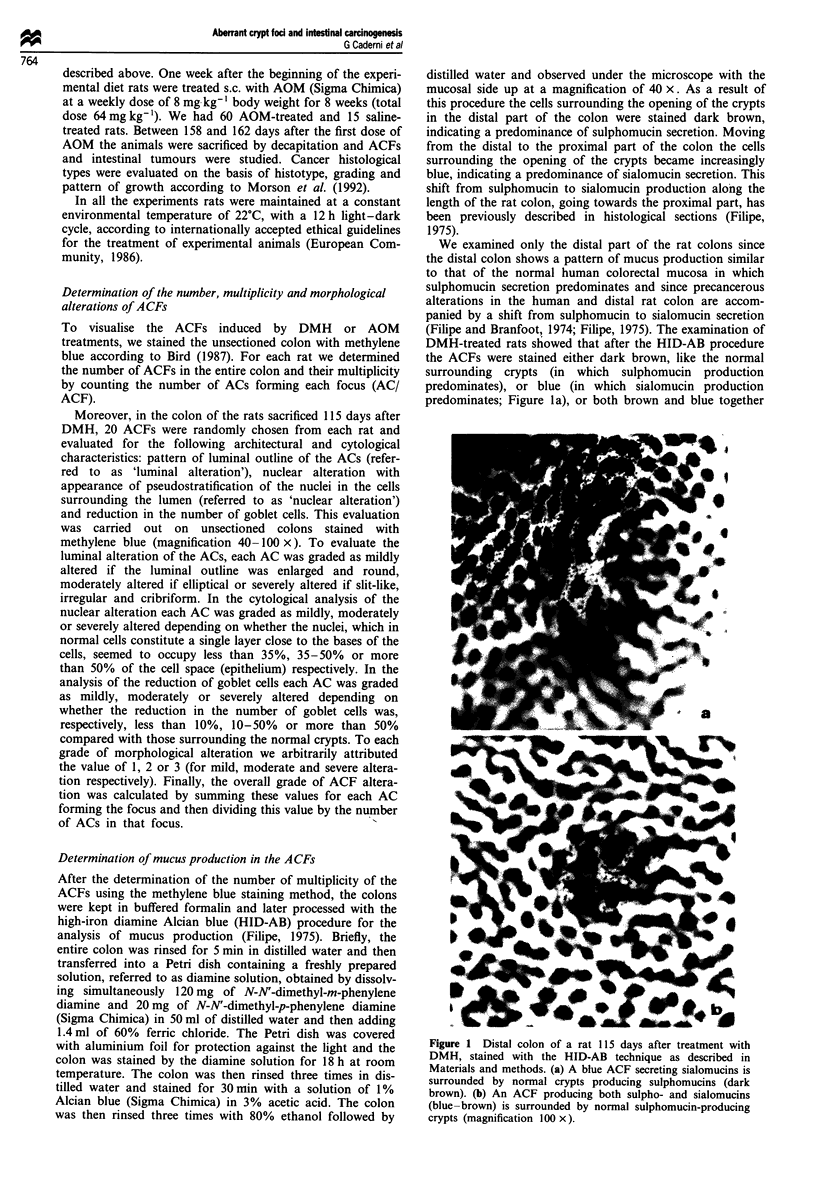
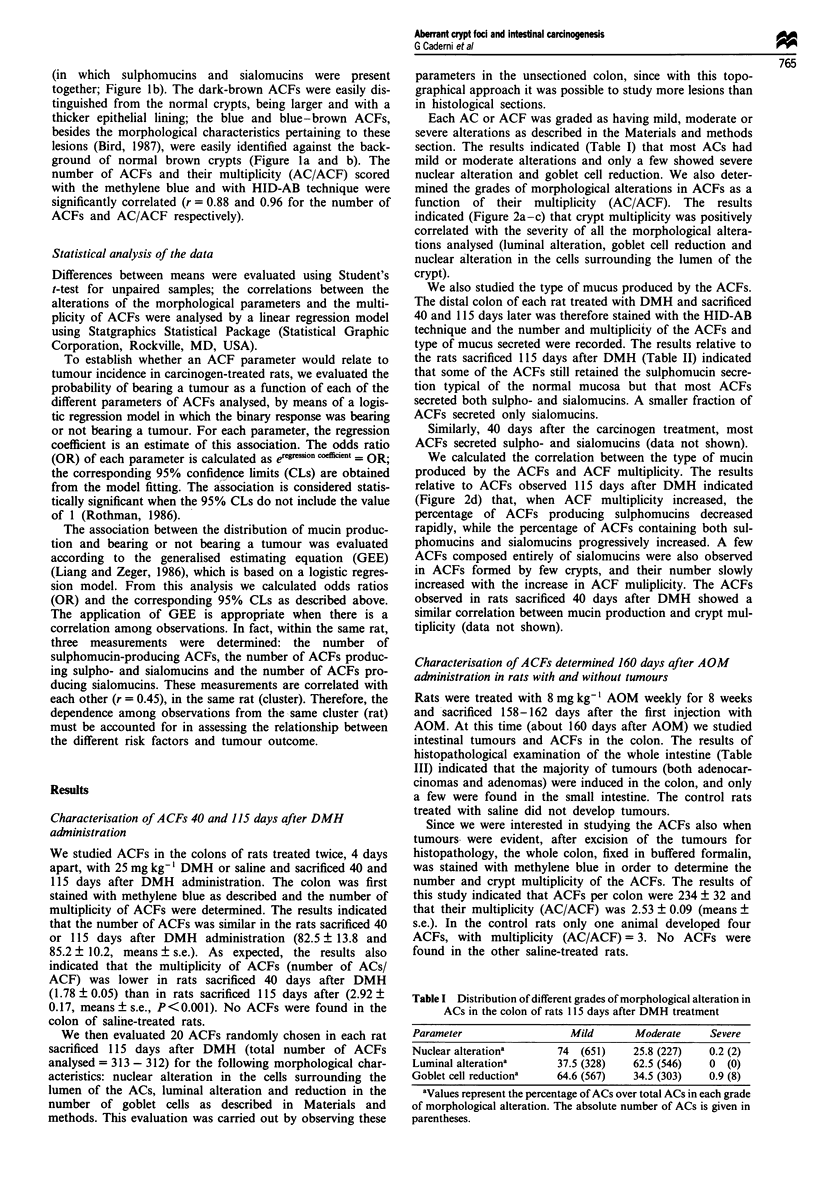
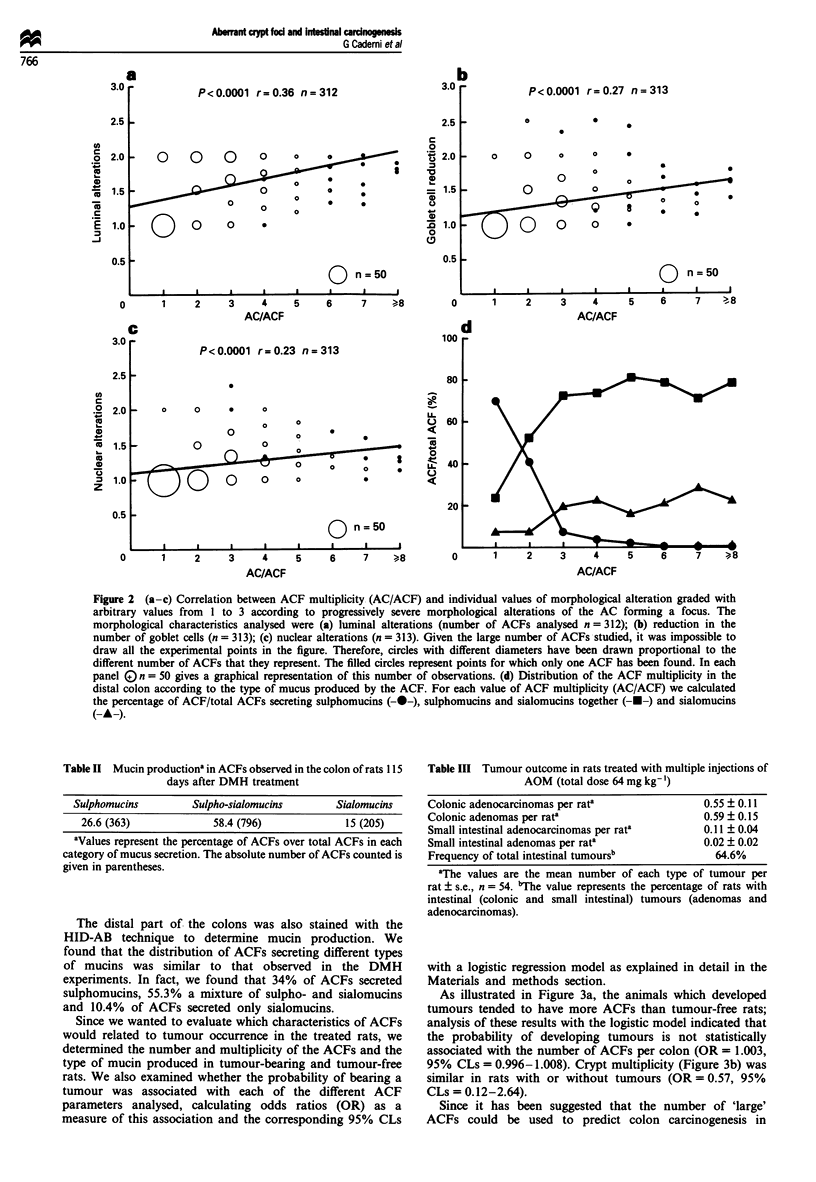
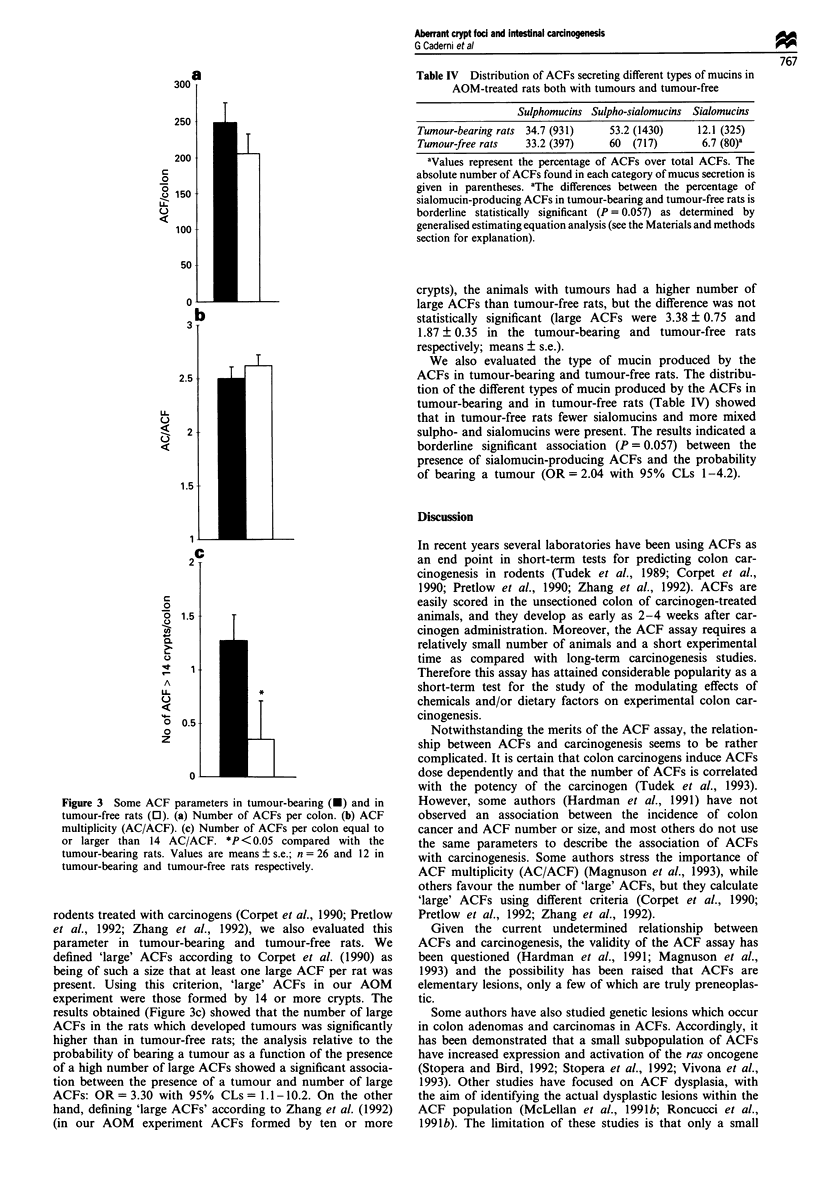
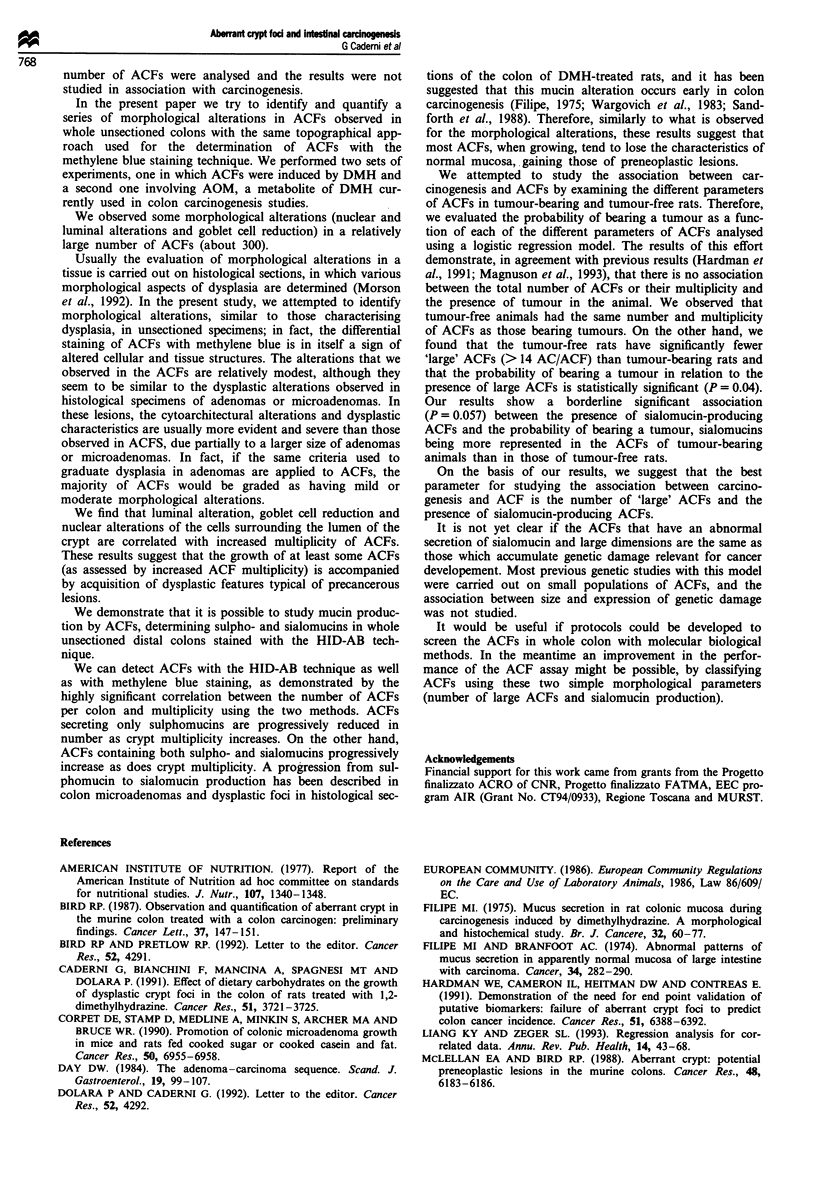
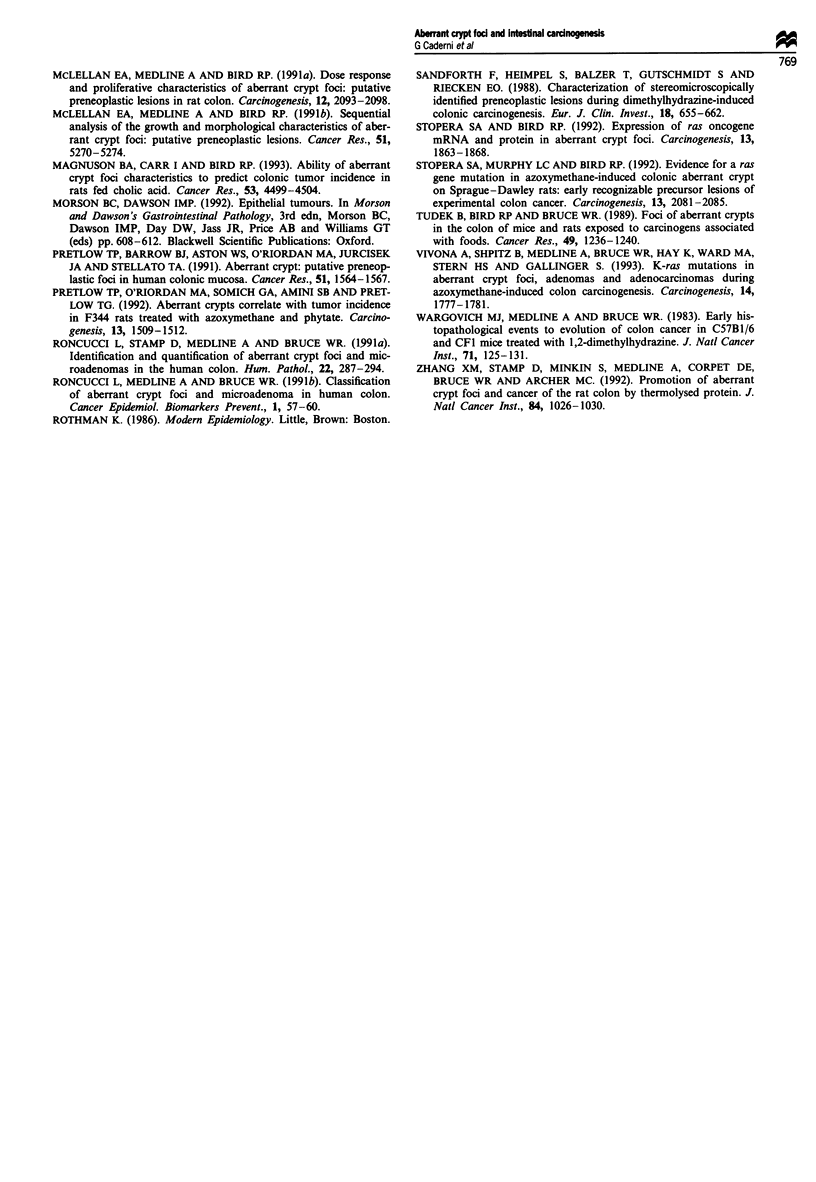
Images in this article
Selected References
These references are in PubMed. This may not be the complete list of references from this article.
- Bird R. P. Observation and quantification of aberrant crypts in the murine colon treated with a colon carcinogen: preliminary findings. Cancer Lett. 1987 Oct 30;37(2):147–151. doi: 10.1016/0304-3835(87)90157-1. [DOI] [PubMed] [Google Scholar]
- Bird R. P., Pretlow T. P. Correspondence re: Giovanna Caderni et al., Effect of dietary carbohydrates on the growth of dysplastic crypt foci in the colon of rats treated with 1,2-dimethylhydrazine. Cancer Res., 51:3721-3725, 1991. Cancer Res. 1992 Aug 1;52(15):4291–4292. [PubMed] [Google Scholar]
- Caderni G., Bianchini F., Mancina A., Spagnesi M. T., Dolara P. Effect of dietary carbohydrates on the growth of dysplastic crypt foci in the colon of rats treated with 1,2-dimethylhydrazine. Cancer Res. 1991 Jul 15;51(14):3721–3725. [PubMed] [Google Scholar]
- Corpet D. E., Stamp D., Medline A., Minkin S., Archer M. C., Bruce W. R. Promotion of colonic microadenoma growth in mice and rats fed cooked sugar or cooked casein and fat. Cancer Res. 1990 Nov 1;50(21):6955–6958. [PubMed] [Google Scholar]
- Day D. W. The adenoma-carcinoma sequence. Scand J Gastroenterol Suppl. 1984;104:99–107. [PubMed] [Google Scholar]
- Filipe M. I., Branfoot A. C. Abnormal patterns of mucus secretion in apparently normal mucosa of large intestine with carcinoma. Cancer. 1974 Aug;34(2):282–290. doi: 10.1002/1097-0142(197408)34:2<282::aid-cncr2820340211>3.0.co;2-w. [DOI] [PubMed] [Google Scholar]
- Filipe M. I. Mucous secretion in rat colonic mucosa during carcinogenesis induced by dimethylhydrazine. A morphological and histochemical study. Br J Cancer. 1975 Jul;32(1):60–77. doi: 10.1038/bjc.1975.134. [DOI] [PMC free article] [PubMed] [Google Scholar]
- Hardman W. E., Cameron I. L., Heitman D. W., Contreras E. Demonstration of the need for end point validation of putative biomarkers: failure of aberrant crypt foci to predict colon cancer incidence. Cancer Res. 1991 Dec 1;51(23 Pt 1):6388–6392. [PubMed] [Google Scholar]
- Liang K. Y., Zeger S. L. Regression analysis for correlated data. Annu Rev Public Health. 1993;14:43–68. doi: 10.1146/annurev.pu.14.050193.000355. [DOI] [PubMed] [Google Scholar]
- Magnuson B. A., Carr I., Bird R. P. Ability of aberrant crypt foci characteristics to predict colonic tumor incidence in rats fed cholic acid. Cancer Res. 1993 Oct 1;53(19):4499–4504. [PubMed] [Google Scholar]
- McLellan E. A., Bird R. P. Specificity study to evaluate induction of aberrant crypts in murine colons. Cancer Res. 1988 Nov 1;48(21):6183–6186. [PubMed] [Google Scholar]
- McLellan E. A., Medline A., Bird R. P. Dose response and proliferative characteristics of aberrant crypt foci: putative preneoplastic lesions in rat colon. Carcinogenesis. 1991 Nov;12(11):2093–2098. doi: 10.1093/carcin/12.11.2093. [DOI] [PubMed] [Google Scholar]
- McLellan E. A., Medline A., Bird R. P. Sequential analyses of the growth and morphological characteristics of aberrant crypt foci: putative preneoplastic lesions. Cancer Res. 1991 Oct 1;51(19):5270–5274. [PubMed] [Google Scholar]
- Pretlow T. P., Barrow B. J., Ashton W. S., O'Riordan M. A., Pretlow T. G., Jurcisek J. A., Stellato T. A. Aberrant crypts: putative preneoplastic foci in human colonic mucosa. Cancer Res. 1991 Mar 1;51(5):1564–1567. [PubMed] [Google Scholar]
- Pretlow T. P., O'Riordan M. A., Somich G. A., Amini S. B., Pretlow T. G. Aberrant crypts correlate with tumor incidence in F344 rats treated with azoxymethane and phytate. Carcinogenesis. 1992 Sep;13(9):1509–1512. doi: 10.1093/carcin/13.9.1509. [DOI] [PubMed] [Google Scholar]
- Roncucci L., Medline A., Bruce W. R. Classification of aberrant crypt foci and microadenomas in human colon. Cancer Epidemiol Biomarkers Prev. 1991 Nov-Dec;1(1):57–60. [PubMed] [Google Scholar]
- Roncucci L., Stamp D., Medline A., Cullen J. B., Bruce W. R. Identification and quantification of aberrant crypt foci and microadenomas in the human colon. Hum Pathol. 1991 Mar;22(3):287–294. doi: 10.1016/0046-8177(91)90163-j. [DOI] [PubMed] [Google Scholar]
- Sandforth F., Heimpel S., Balzer T., Gutschmidt S., Riecken E. O. Characterization of stereomicroscopically identified preneoplastic lesions during dimethylhydrazine-induced colonic carcinogenesis. Eur J Clin Invest. 1988 Dec;18(6):655–662. doi: 10.1111/j.1365-2362.1988.tb01283.x. [DOI] [PubMed] [Google Scholar]
- Stopera S. A., Bird R. P. Expression of ras oncogene mRNA and protein in aberrant crypt foci. Carcinogenesis. 1992 Oct;13(10):1863–1868. doi: 10.1093/carcin/13.10.1863. [DOI] [PubMed] [Google Scholar]
- Stopera S. A., Murphy L. C., Bird R. P. Evidence for a ras gene mutation in azoxymethane-induced colonic aberrant crypts in Sprague-Dawley rats: earliest recognizable precursor lesions of experimental colon cancer. Carcinogenesis. 1992 Nov;13(11):2081–2085. doi: 10.1093/carcin/13.11.2081. [DOI] [PubMed] [Google Scholar]
- Tudek B., Bird R. P., Bruce W. R. Foci of aberrant crypts in the colons of mice and rats exposed to carcinogens associated with foods. Cancer Res. 1989 Mar 1;49(5):1236–1240. [PubMed] [Google Scholar]
- Vivona A. A., Shpitz B., Medline A., Bruce W. R., Hay K., Ward M. A., Stern H. S., Gallinger S. K-ras mutations in aberrant crypt foci, adenomas and adenocarcinomas during azoxymethane-induced colon carcinogenesis. Carcinogenesis. 1993 Sep;14(9):1777–1781. doi: 10.1093/carcin/14.9.1777. [DOI] [PubMed] [Google Scholar]
- Wargovich M. J., Medline A., Bruce W. R. Early histopathologic events to evolution of colon cancer in C57BL/6 and CF1 mice treated with 1,2-dimethylhydrazine. J Natl Cancer Inst. 1983 Jul;71(1):125–131. [PubMed] [Google Scholar]
- Zhang X. M., Stamp D., Minkin S., Medline A., Corpet D. E., Bruce W. R., Archer M. C. Promotion of aberrant crypt foci and cancer in rat colon by thermolyzed protein. J Natl Cancer Inst. 1992 Jul 1;84(13):1026–1030. doi: 10.1093/jnci/84.13.1026. [DOI] [PubMed] [Google Scholar]



